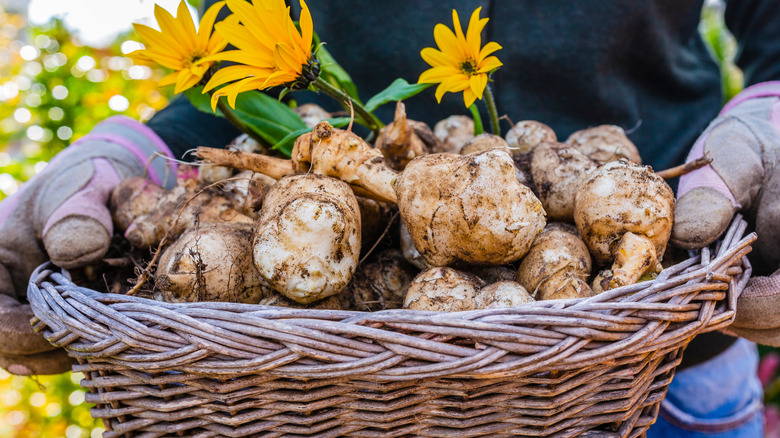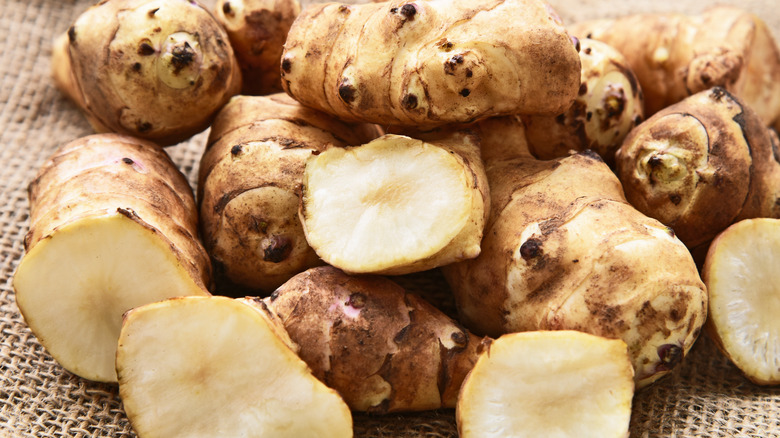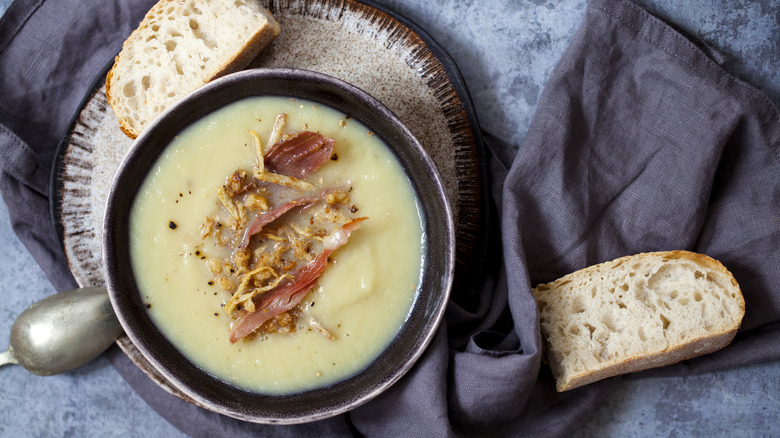What Are Sunchokes And What Do They Taste Like?
Sunchokes, sometimes called Jerusalem artichokes, are a wonderful and unique vegetable option that far too often go overlooked. They are excellent fried, steamed, sautéed, boiled, mashed, roasted, sliced, raw — the list goes on and on. They are packed with nutrition, flavor, and are totally versatile. (We'll give you a moment to add them to your shopping list.)
Sunchokes are native to North America and are perennial crops. They were originally cultivated and harvested by Indigenous Americans, according to Fine Cooking. Sunchokes are technically a rhizome or a tuber, not a root vegetable, because they are actually the stem of a plant within the sunflower family. A sunchoke is not the most appealing aesthetically: it can be knobby, unattractive, and gnarled, but when cooked, its soft, creamy, pale interior is rich and delicious, in sharp contrast with its crinkled, thin skin. It tastes like a nutty potato with a slight artichoke aftertaste. When raw, they can resemble ginger root.
While the sunchoke is actually primarily in season during the winter, it is also good in both spring and autumn. Though some prefer to peel the sunchoke, that's not necessary; just give it a rigorous cleaning. Be sure to be vigilant when cleaning, however, because dirt and soil can very easily stuck in the sunchoke's many tiny nooks and crannies.
What do they taste like and how do you cook with them?
Sunchokes truly are exceptionally versatile. Though you might expect them to be similar to potatoes based on appearances, they are not starchy. Sunchokes are wonderful in salads, roasted in the vein of "smashed potatoes," and make excellent pickles. They're also delicious eaten raw, thinly sliced, with nuts, cheese, and fruit; and make a terrific soup or puree. Their subtle nutty sweetness lends itself well to so many preparations, including gluten-free, vegan, or vegetarian options.
In addition to potato or artichoke, some compare the flavor of a sunchoke to jicama or water chestnuts. They are also pair very well with any sort of creamy, mild dairy product, such as yogurt, goat cheese, or ricotta. Because their skin is so thin, sunchokes are great fried. The skin becomes a crispy little morsel that counters the lush creaminess of the flesh. You can even slice them on a mandoline and make irresistible sunchoke chips. Top with some flaky salt and a touch of herbs (rosemary would be ideal), and you have a wonderful snack all ready to go.
Where did sunchokes (or Jerusalem artichokes) get their name?
As Garden & Gun notes, the sunchoke "is neither from Jerusalem nor related to the artichoke" and that it is a staple vegetable used in Southern cooking. Serious Eats notes that the "Jerusalem" part of the name might just be a slight linguistic error, a take-off on an improper pronunciation of the word girasole, the Italian word for sunflower. As far as the artichoke part, a French explorer named Samuel de Champlain is said to have compared the flavor of the sunchoke to an artichoke, and the rest is history.
In addition to their culinary diversity, they're also an excellent source of vitamin C, iron, thiamin, phosphors, and potassium, according to Fine Cooking. They're also high in fiber (via Cooking Light).
The next time you're looking for a vegetal flavor to help bolster your pureed soup or you're looking for a delicious fried veggie that is not a potato, look no further than the stellar sunchoke — or Jerusalem artichoke, if you'd rather call it that. No matter what the nomenclature, one thing is for certain: sunchokes are an A+ option in almost any preparation. While they make not be easily found at all grocery stores, they're certainly out there, and you will not be disappointed once you taste the elusive, delicious tuber.


